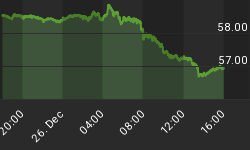The U.S economy continues producing nasty inflation surprises. U.S. inflation hit a 40-year peak in February thanks to strong consumer demand and ongoing supply chain disruptions.
The Federal Reserve's favorite inflation calculator recorded a sharp 0.6% increase in February and further justified the central bank's plan to move faster to raise U.S. interest rates. The so-called personal consumption price (PCE) index climbed to 6.4% in the 12 months ended in February, up from 6.2% in the prior month, thus marking the biggest monthly increase since January 1982. The Fed views the PCE index as the most accurate measure of U.S. inflation since it takes into account when consumers substitute cheaper goods for more expensive ones.
The more widely used consumer price index (CPI) rose by an even higher 7.9% in the 12 months ended February.
Higher interest rates probably won't do much to curtail inflation in the short run, but could cool down demand for houses, autos, and other big-ticket items. In the meantime, most companies are raising prices, and workers are asking for bigger pay raises--a vicious cycle likely to contribute to even higher inflation.
Indeed, monetary policymakers are worried that the so-called wage-price spiral will not only contribute to more inflation but also erode workers' purchasing power.
Stopping The Wage-Price Spiral
In the popular imagination, workers can stay ahead of the rising cost of living as long as they demand higher wages. Businesses can then protect their margins by passing at least part of these costs to consumers through price increases. This school of thinking has been informed by the experiences of the 1960s and 70s when union bosses were able to negotiate above-inflation pay increases for their members. In a particularly memorable case in 1974, Germany's infamous Kluncker-Runde, Heinz Kluncker, a combative unionist, won public-sector workers a budget-busting 11% pay rise. We can clearly see this in contemporary American politics: President Joe Biden has been celebrating rising pay while left-wing politicians continue to blame corporate greed for rising prices.
Unfortunately, since those halcyon days, workers have nearly always been on the receiving end of rising inflation. Modern-day labor unions are much less powerful today than their predecessors four or five decades ago, and study after study typically finds that higher prices lead wages, rather than vice versa. Over the past year, inflation has been higher than wage growth in every G7 country, despite widespread labor shortages. In 2021, nominal wages and salaries for all American civilian workers climbed at an impressive 4.4% annual clip, the fastest increase since 1983. Unfortunately, prices also rose rapidly, leading to inflation-adjusted wages falling 2.4% Y/Y.
Indeed, even in the 1970s, many American workers suffered from the adverse effects of the wage-price spiral, with wages growing only half as fast as workers' productivity, just as today's wages have yet to catch up with such gains.
High inflation in Europe can mostly be pinned on the global energy crisis and high energy costs. However, high inflation in the United States can be chalked up to massive government stimulus coupled with low interest rates, overwhelming the economy's capacity to expand production. For perspective, the Obama administration's stimulus package in response to the 2008 recession was $787 billion; the pandemic stimulus packages, between the Trump and the Biden administrations, are ~$5 trillion. While the stimulus has had a positive effect on the economy, it came as the pandemic drove people to buy products rather than services. Those purchases of couches, cars, refrigerators, and other items came as the country's supply chain remained beleaguered, driving up demand.
As consumer-price inflation has risen to 7.9%, annual wage growth of 5.7% has failed to keep up, leading to falling purchasing power. Unfortunately, the American worker might have to swallow a bitter pill to stem this malaise. The wage-price spirals of the 1970s were only brought under control after tight monetary policy induced a global downturn which, in turn, forced American unemployment to peak at nearly 11%. Things might get worse for the American worker before they get better.

















